
Ever dreamed of baking the famous Lion House Rolls from Utah’s Lion House Restaurant in your own kitchen? Imagine creating bread so soft and fluffy, it seems to melt upon tasting. That’s the magic of the Lion House rolls, and our copycat recipe brings this culinary art to your home with a twist, literally. Soft knotted dinner rolls are perfect for every bread lover. This recipe is your key to making the best dinner rolls. You’ll craft homemade dinner roll knots with a crispy crust and soft, tender insides, rivaling the Lion House Bakery’s famed creation.
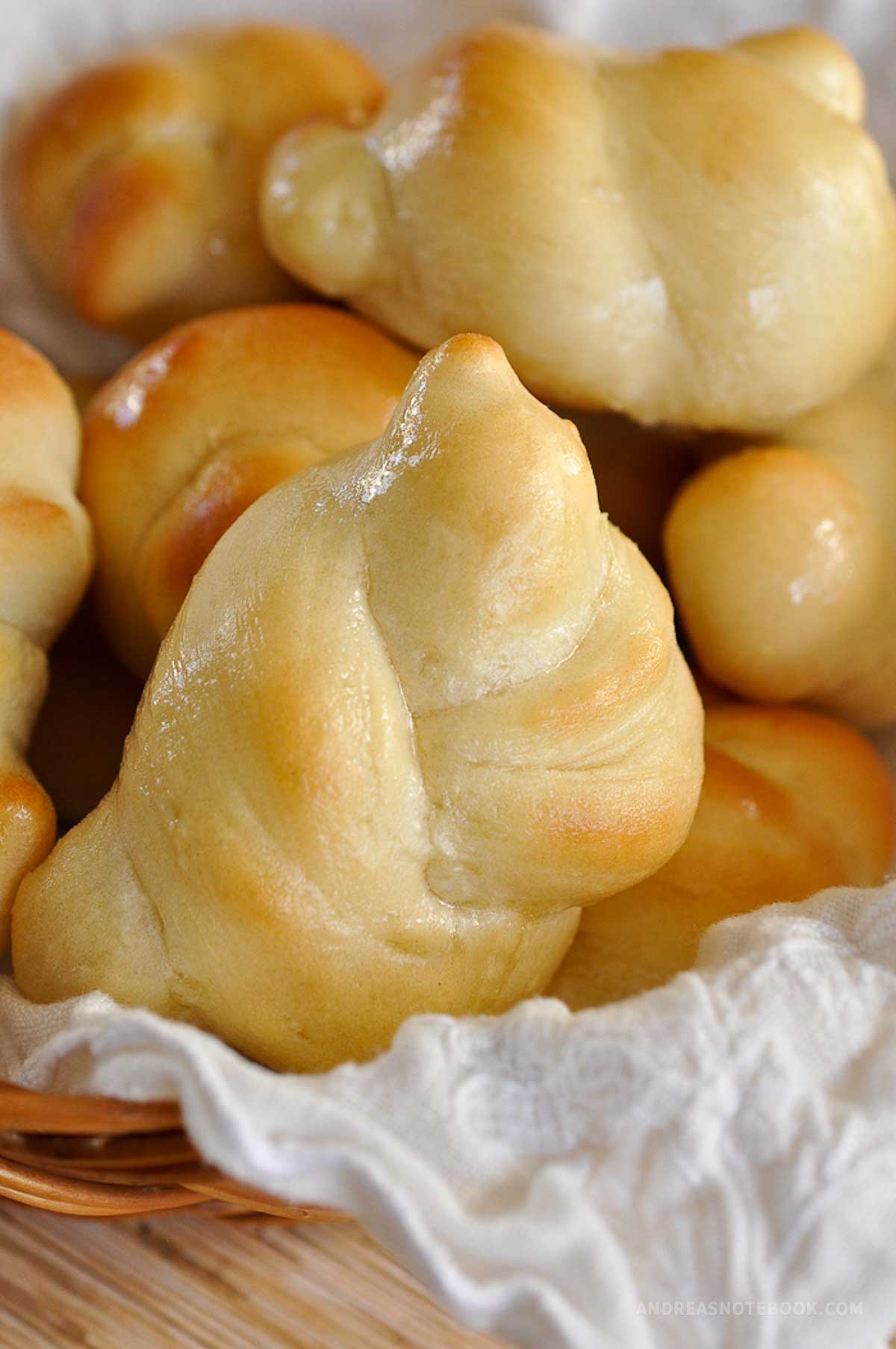
This good roll recipe is straightforward, promising joy in every baking step. Whether you’re a baking expert or a first-timer, these amazing Lion House Rolls will elevate your bread-making skills. The fluffy yeast dough makes a perfect knotted yeast dinner roll. Welcome to the journey of making soft, buttery perfection with our Lion House Rolls copycat recipe.
Secret To Fluffy Rolls
What sets Lion House Rolls apart as a popular yeast dinner roll? It’s their signature fluffiness. The Lion House rolls recipe masterfully combines key ingredients to create an exceptionally soft dough. Flour, yeast, and milk blend under precise conditions, forming a tender, airy structure. It’s not just the ingredients, but their combination and handling that make the difference.
Kneading and proving the dough are crucial, where yeast fermentation and gluten development reach perfection. This process results in a soft dough that bakes into cloud-like rolls. This blog delves into the Lion House rolls recipe, revealing the secrets behind these beloved dinner table staples. Bakers, get ready to explore and replicate this fluffiness in your own kitchen.
Ingredients
Full ingredients amounts and step-by-step instructions for this legendary Lion House rolls dough can be found below in the recipe card. Step-by-step photos can be seen below.
- Butter: For this recipe, butter is used on the outside of the rolls. I prefer to use salted butter but this is a personal preference.
- Water: For baking yeast dinner rolls, the water should ideally be between 105°F to 115°F to properly activate the yeast without killing it.
- Yeast: When it comes to baking those perfect yeast dinner rolls, the type of yeast you use can make all the difference. Active dry yeast is the go-to choice for most bakers. It’s known for its dependability and effectiveness in dough rising. This yeast needs to be dissolved in warm water before use, a step that kick-starts the fermentation process, crucial for achieving soft, fluffy rolls. Do not use instant yeast for this recipe.
- Salt: When baking knotted dinner rolls, the choice of salt matters. Opt for fine sea salt or table salt for even distribution throughout the dough. Salt not only enhances flavor but also regulates yeast activity, ensuring your breads rise perfectly and have a delightful taste.
- Sugar: For baking yeast rolls, use granulated sugar. It dissolves easily and feeds the yeast, aiding in a perfect rise and imparting a subtle sweetness to your knotty rolls.
- Dry Powdered Milk: In a yeast dinner roll recipe, dry powdered milk plays a crucial role. It enhances the bread’s texture, making it softer and more tender. Dry milk powder adds richness to the flavor without increasing the liquid content, which could affect the dough’s consistency. Its addition also contributes to a better crust color, lending a visually appealing golden-brown finish to your rolls. Essentially, it’s a secret ingredient for perfectly textured and flavorful homemade rolls.
- Egg: In a yeast roll recipe, an egg enriches the dough, contributing to a richer flavor and a more tender crumb. It adds moisture, which helps to create soft, fluffy rolls. The egg also aids in binding the ingredients together, ensuring a cohesive and smooth dough. It’s best to use an egg that is at room temperature.
- Flour: When it comes to baking yeast rolls, the type of flour you use can significantly influence the outcome. This recipe uses all purpose flour. All-purpose flour, the most commonly used type, is versatile and creates a good balance of softness and structure in the rolls. Its moderate protein content ensures that your rolls are tender but still have enough gluten to hold their shape. Bread flour will yield different results.
More Bread Recipes You’ll Love
Need bread to accompany your dinner? Make an easy Garlic Naan Bread or a Fluffy Focaccia Bread. Need easy? Try Cheesy Garlic Rolls.
Instructions
Baking the perfect roll, especially a copycat Lion House rolls recipe, is an art that combines skill, patience, and a bit of science. The key to success lies in the details – from mixing and kneading the dough to achieving that ideal rise. Here’s a step-by-step guide to help you bake buttery dinner rolls that are fluffy, golden, and utterly delicious.
Make The Bread Dough:
Step 1: In a large bowl, preferably the bowl of a stand mixer, combine warm water and active dry yeast. Let the yeast mixture sit until frothy – about 5-10 minutes.
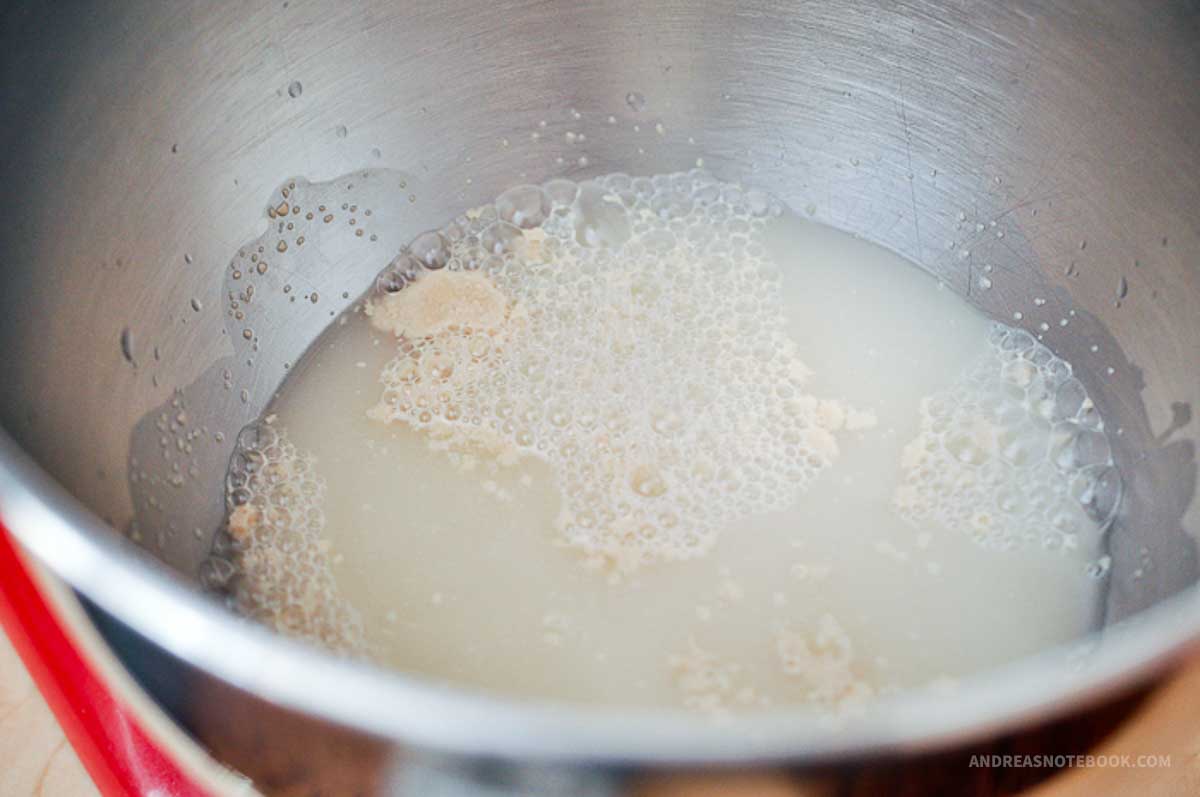
Step 2: As the yeast is dissolving, in a separate small mixing bowl, combine salt, sugar and powdered milk.
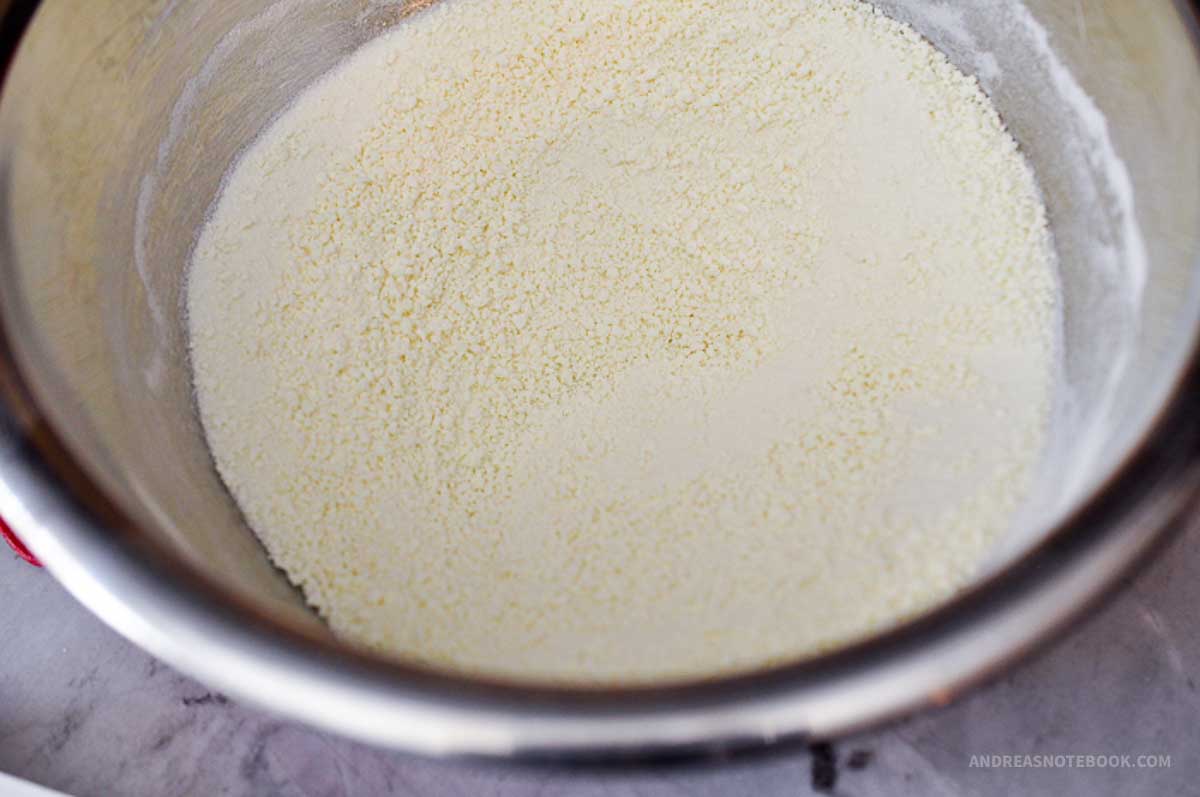
Step 3: Combine the dry ingredients with the yeasty water in the stand mixer bowl. Add an egg.
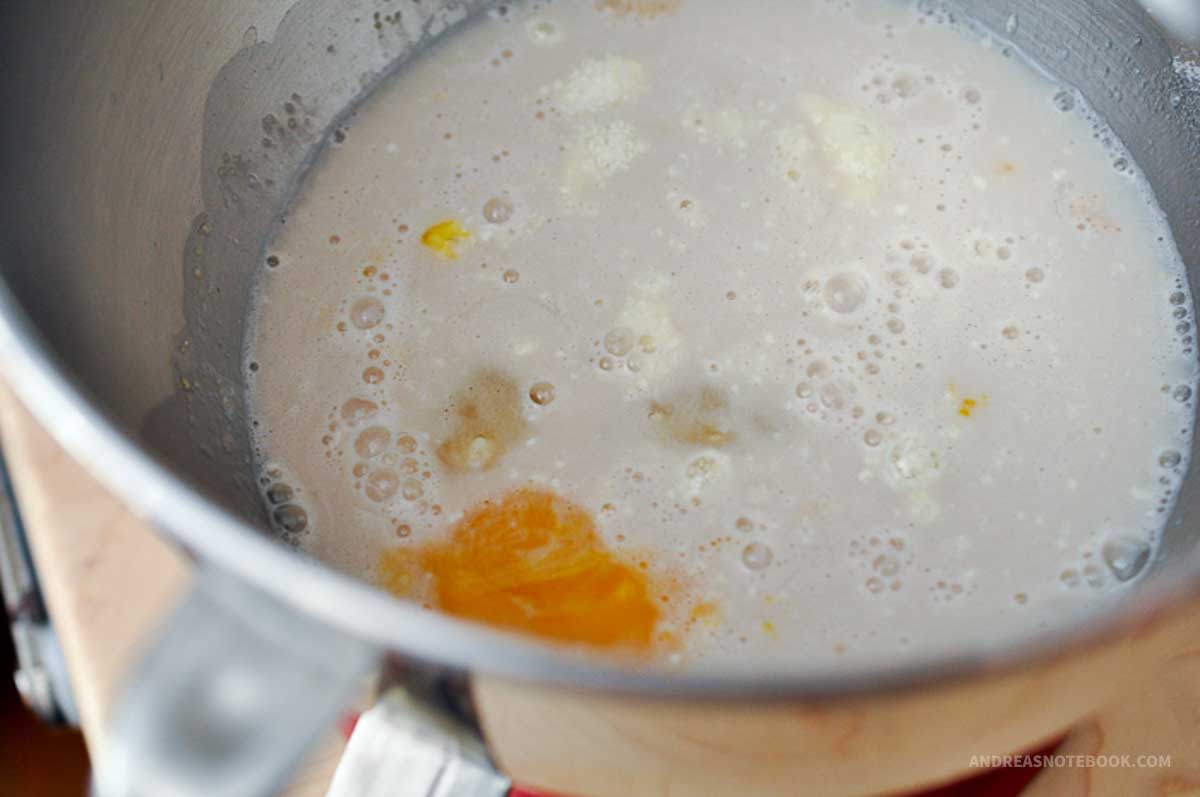
Step 4: Mix in 1 cup of flour. I use a dough hook attachment on the Kitchen Aid Mixer on low speed. Gradually add the remaining flour, 1 cup at a time. You may not need the entire amount of flour but 5 cups of flour is a good starting point. The amount of flour that you will need will vary with humidity, elevation, etc. You don’t want the dough too sticky OR too dry.

Step 5: Once all flour is added, mix on medium speed until a ball of dough forms and pulls away from the sides of the bowl. Continue kneading for about 5 minutes.
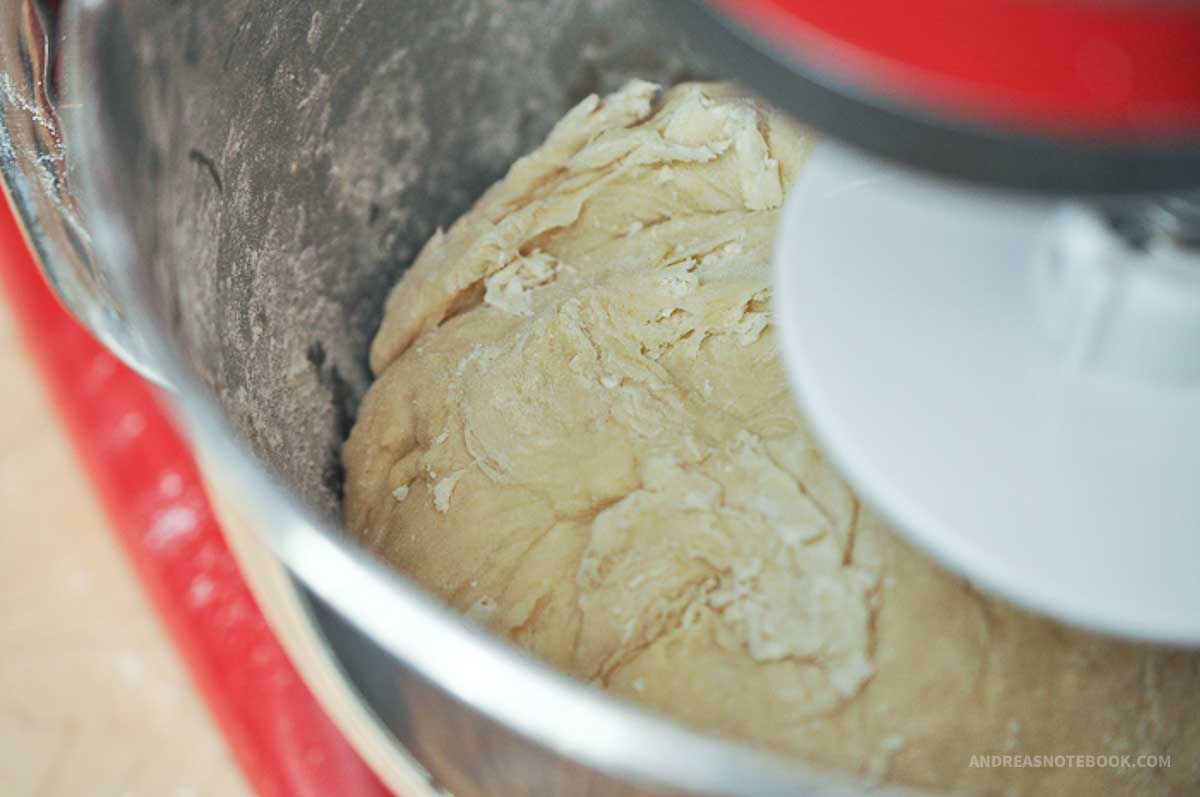
First Rise:
Step 6: Place dough in a greased bowl (the bottom and sides of bowl should be greased), turning the ball once to coat.
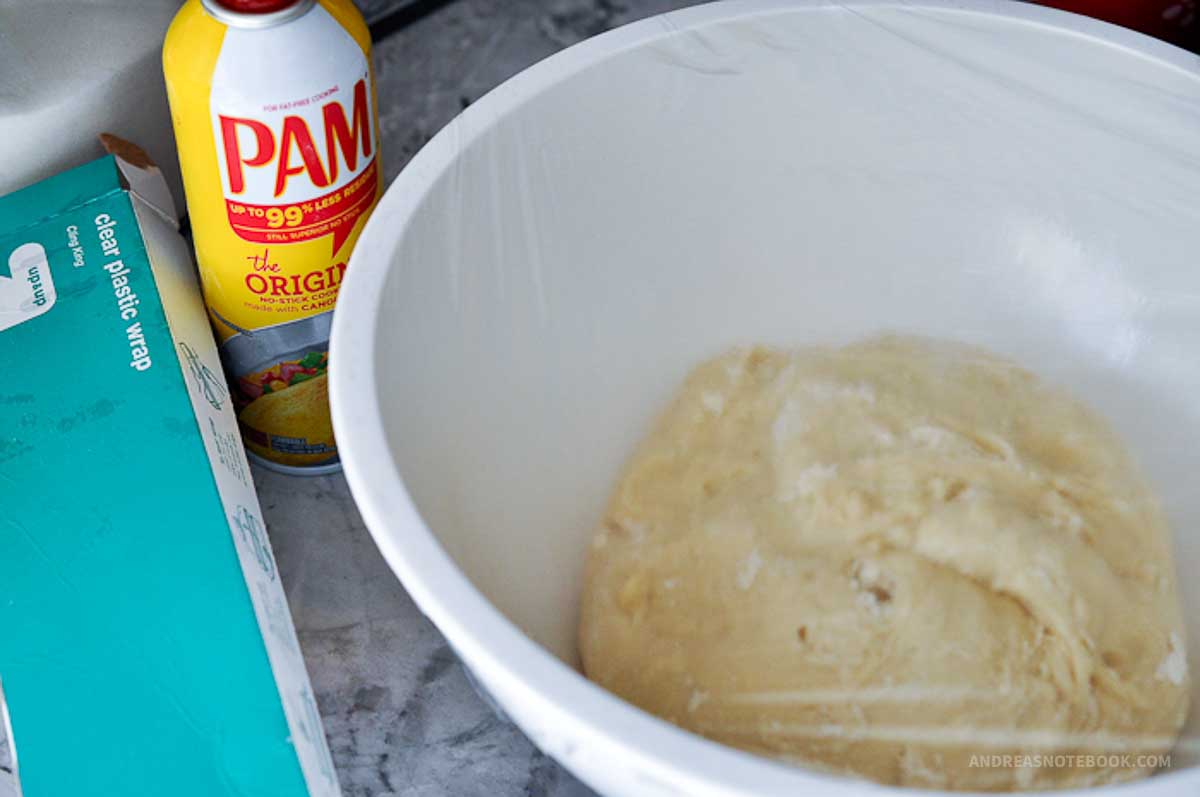
Step 7: Cover with plastic wrap and let the dough rise in a warm place until doubled in size, about 1-2 hours. If your kitchen is cool find the warmest area of the house to let the bowl rise.
Step 8: Gently punch dough down the dough to release air bubbles.

Shaping the Knotted Rolls:
Step 9: Once the dough has doubled in size, turn the dough onto a lightly floured surface and roll it into a large rectangle shape.

Step 10: Using a pizza cutter or sharp knife, cut the dough into 24 even small rectangles. Roll dough into a long rope shape
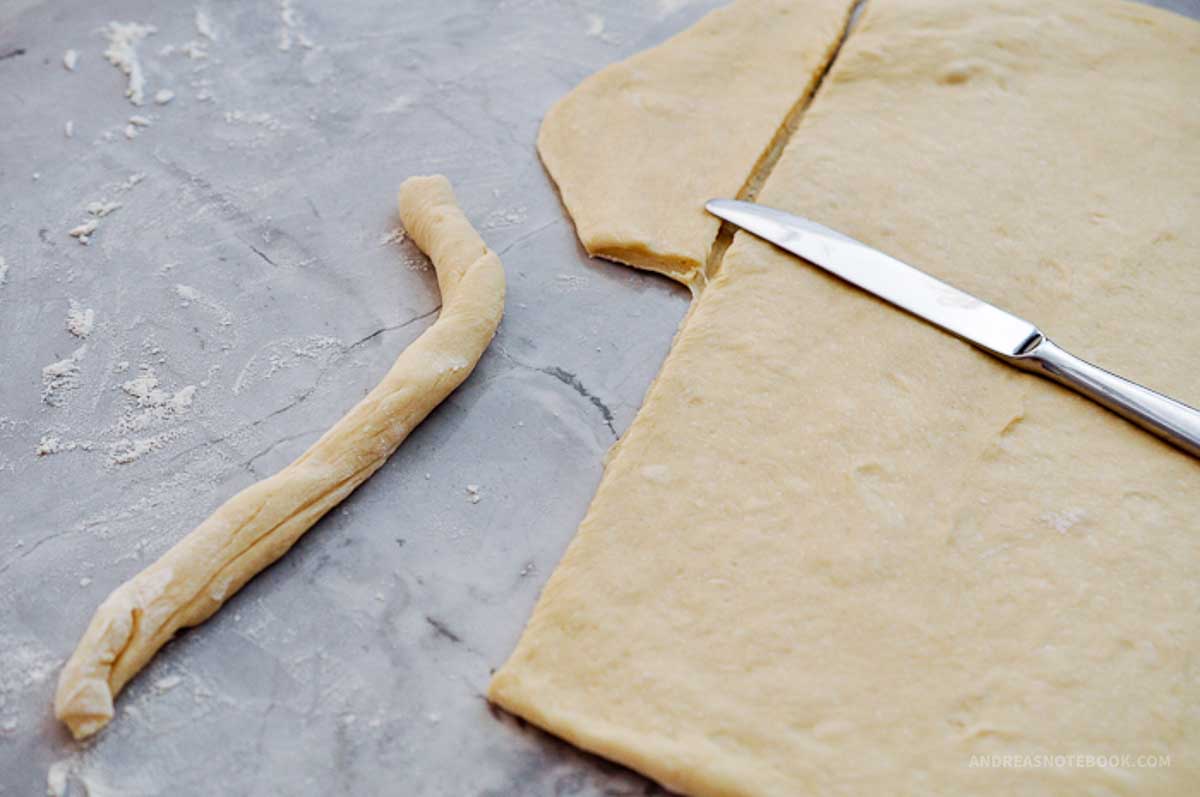
Step 11: Twist rope into a loose knot. Place rolls on a baking sheet lined with parchment paper. You could also roll the dough like classic Lion House rolls. Knotted dinner rolls are just a bit more fun, for us.

Second Rise:
Step 12: Place the rolls on a cookie sheet that has been lightly sprayed with cooking spray. Cover the shaped rolls with a light towel and let them rise in a warm spot until they are puffy, about 1 hour.

Step 13: Brush the top of the dough with melted butter using a pastry brush.
Baking:
Step 14: Preheat your oven to 350°F.
Step 15: Bake the knotted rolls for 12-15 minutes or until they are golden brown on top. Larger pieces will take longer to bake.
Step 16: Remove from the oven and brush the top of the rolls again with a little bit of melted butter. Serve homemade knotted dinner rolls warm for the best experience.

Creating these copycat Lionhouse rolls might seem daunting at first time, but the process is incredibly rewarding. The key to perfect rolls lies in paying attention to each step – ensuring the dough is the right consistency, letting it rise sufficiently, and baking it just enough to achieve that golden brown perfection. Remember, practice makes perfect, and each batch you make will bring you closer to mastering the art of the perfect roll. Happy baking!
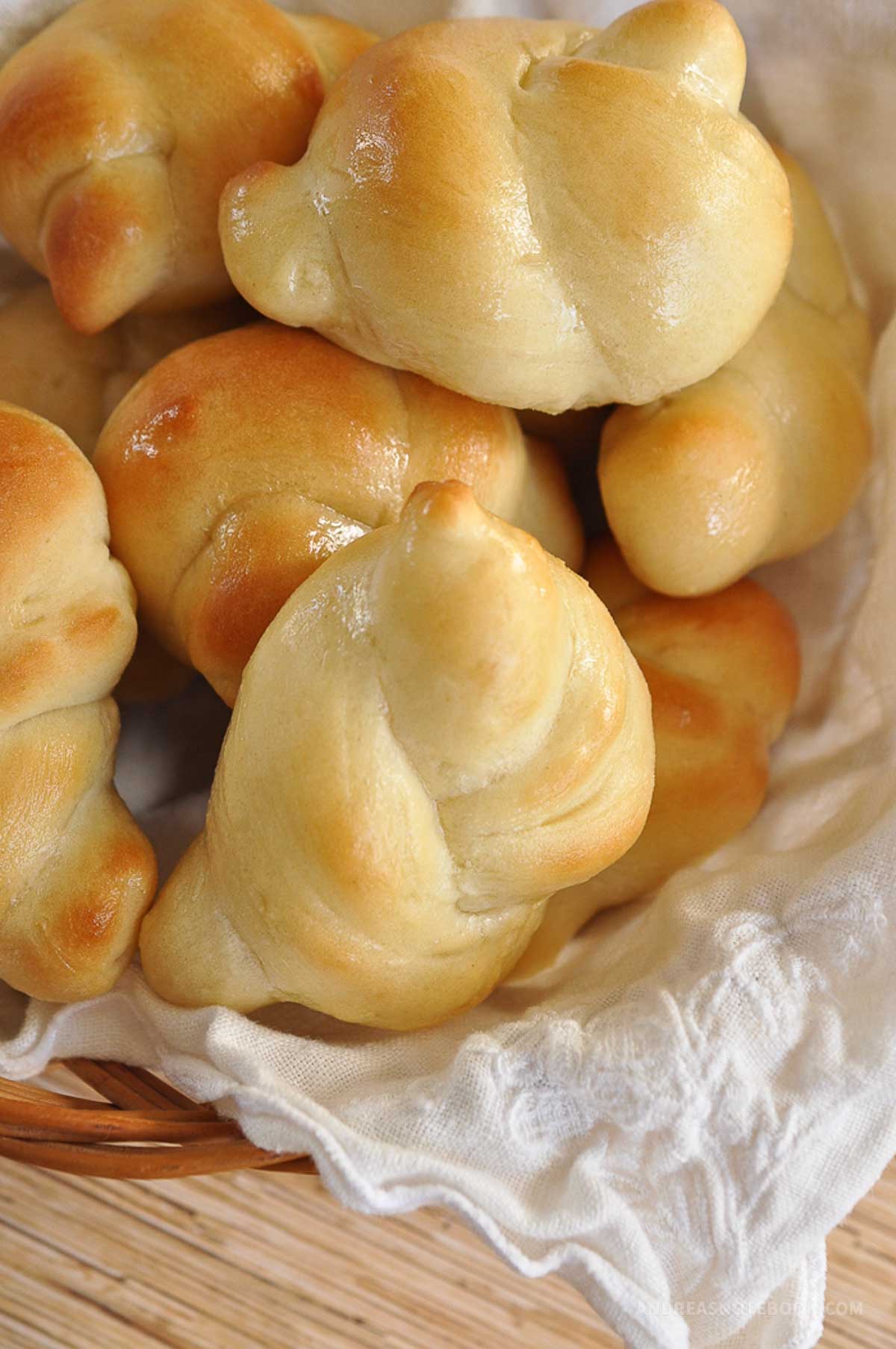
Serving Suggestions
Fresh from the oven, your copycat Lion House rolls are a delightful treat. But why stop there? Elevate these fluffy wonders with creative serving ideas and buttery spreads that turn them from simple rolls into a gourmet experience. Perfect for holiday meals or any gathering, these ideas are sure to impress your guests.
1. Sweet and Savory Spreads:
- Honey Butter: Combine softened butter with honey for a sweet, rich spread that melts beautifully on warm rolls.
- Herbed Butter: Mix butter with fresh herbs like rosemary or thyme for a savory twist.
- Cinnamon Sugar Butter: Ideal for those who love a sweet touch, blend butter with cinnamon and sugar.
2. Soup and Salad Side:
- Serve these rolls alongside your favorite soup or salad. They’re perfect for dipping or as a hearty accompaniment.
3. Themed Spreads for Holiday Meals:
- For Thanksgiving, pair with cranberry butter or pumpkin spice spread.
- During Christmas, offer peppermint-flavored butter or a nutty almond spread.
4. Garlic Parmesan Rolls:
- Brush your rolls with garlic butter and sprinkle Parmesan cheese on top before baking for an extra flavorful touch.
5. Classic Dinner Roll:
- Sometimes, simplicity is key. Serve your rolls warm with plain butter for a classic, comforting experience.
6. Poppy Seeds:
- Sprinkle poppy seeds over the knotted dinner rolls after they’re baked and after topping with butter.
These serving ideas and spreads are perfect for bringing out the best in your Lion House copycat rolls. Whether it’s a cozy family dinner or a festive holiday meal, these creative touches add flavor and fun to your table. Enjoy the process of experimenting with different combinations and watch as these rolls become a much-anticipated highlight of your meal.
How To Store, Freeze And Reheat Dinner Rolls
Yeast dinner rolls, with their delightful aroma and taste, can be a comforting addition to any meal. But what do you do with the leftovers? Storing, freezing, and reheating them correctly can ensure they remain as delicious as when they first came out of the oven. Here’s how to keep your rolls fresh and ready to enjoy anytime.
Storing Freshly Baked Rolls:
- Once your rolls have cooled completely, place them in an airtight container. This keeps them from drying out and maintains their soft texture.
- Keep the container at room temperature if you plan to consume the rolls within a couple of days.
Freezing Yeast Dinner Rolls:
- For longer storage, freezing is your best bet. Wrap each roll individually in plastic wrap or aluminum foil.
- Place the wrapped rolls in a large airtight container or a freezer bag.
- Frozen rolls can last for up to a month without losing their quality.
Reheating Yeast Dinner Rolls:
- When you’re ready to enjoy your rolls again, there are a couple of ways to reheat them.
- For oven reheating, preheat your oven to 350°F. Place the rolls on a baking sheet and cover them with foil to prevent them from drying out. Heat for about 10-15 minutes.
- If you’re short on time, you can also microwave the rolls. Wrap them in a damp paper towel and microwave on high for 20-30 seconds. This method works best when reheating individual rolls.
By following these simple steps, you can enjoy your yeast dinner rolls just as much the second time around. The key is in ensuring they’re stored in an airtight container to retain their moisture and flavor, whether on the counter or in the freezer. So go ahead, bake a big batch, and rest easy knowing you’ve got the know-how to keep them tasting fresh and delicious!
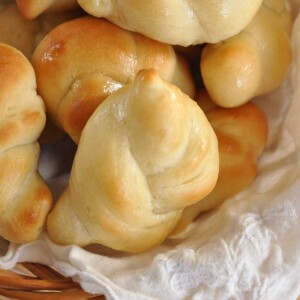
Knotted Yeast Dinner Rolls Recipe
Equipment
- KitchenAid Mixer with dough hook attachment
Ingredients
- 2 cups water lukewarm
- 2 tablespoon active dry yeast
- 1 large egg
- 1 ½ teaspoon salt
- ½ cup sugar
- ⅔ cup dry powdered milk
- 5 cups flour
- 4 tablespoon butter salted
Instructions
Make Dough
- Put the yeast into a bowl of warm water and allow it to dissolve for approximately 5-10 minutes.
- As the yeast is dissolving, mix together the salt, sugar, and powdered milk and set aside.
- Add the dry ingredient mixture and egg to the yeast water and mix.
- Mix 5 cups of flour into the mixture, ONE CUP AT A TIME. The amount of flour needed will vary depending on humidity, elevation, etc. The dough should not be sticky and should be pulling away from the side of the bowl.
First Rise
- Lightly spray a large bowl with cooking spray and place the dough into the bowl. Lightly spray one side of a piece of cellophane wrap and place it over the top of the bowl, sprayed side facing the dough.
- Place the dough in a warm spot and allow it to rise for 2-3 hours, or until doubled in size.
Second Rolls
- Roll out the dough on a floured surface. Cut and form rolls. I usually knot them.
- Place formed rolls on lightly greased cookie sheets. Place lightly sprayed cellophane wrap over the rolls/cookie sheet, sprayed side facing the rolls.
- Place the cookie sheets in a warm spot and allow the rolls to rise for 1+ hours.
Bake
- Bake the rolls at 350 degrees for approximately 12 minutes.
- Melt the butter and brush it on top of the hot rolls.
Notes
Nutrition
Love This Recipe?
Make sure to share it with me on Instagram @andreasnotebook and follow on Pinterest @andreasnotebook for more!
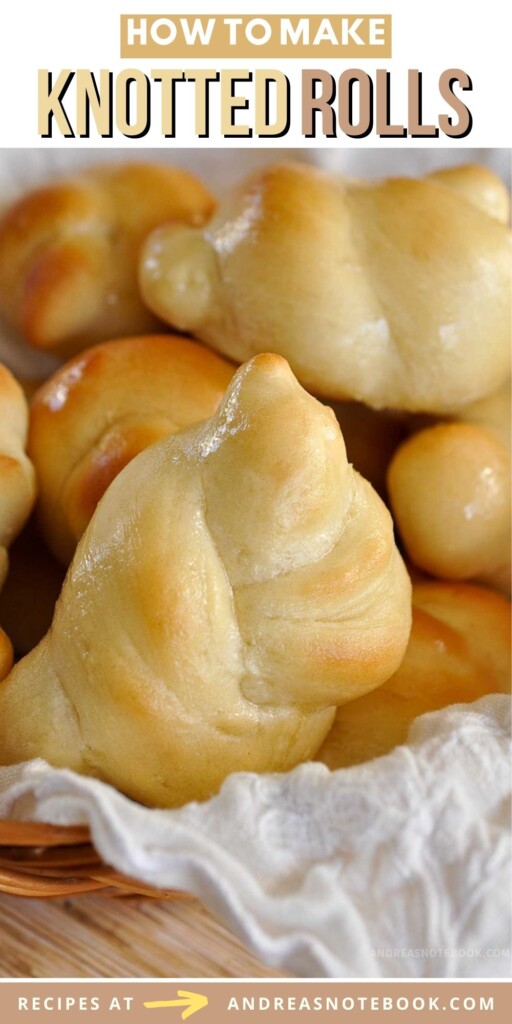
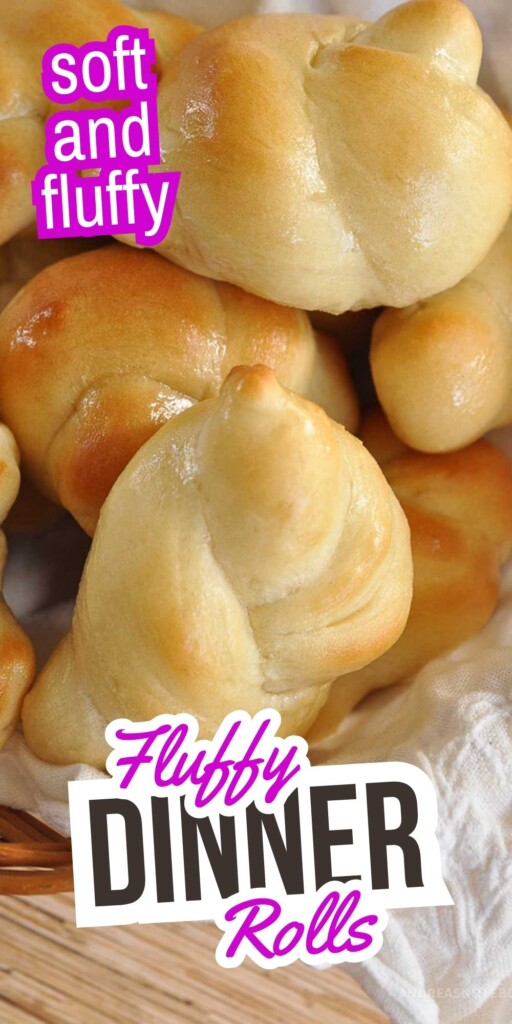

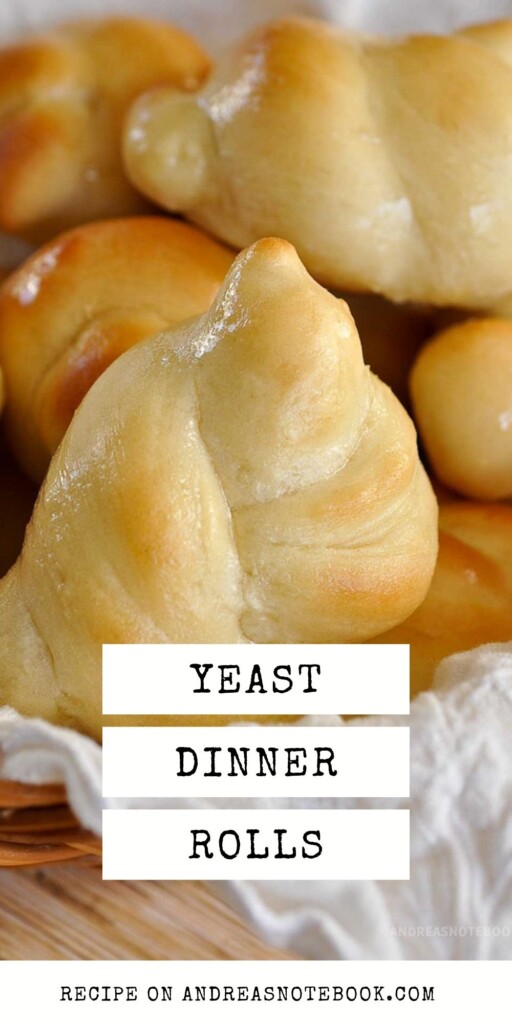

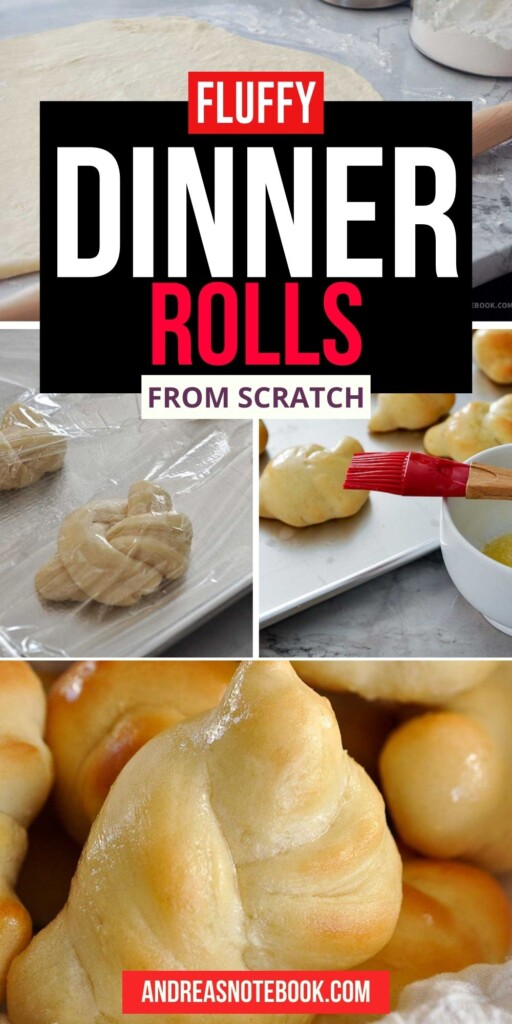
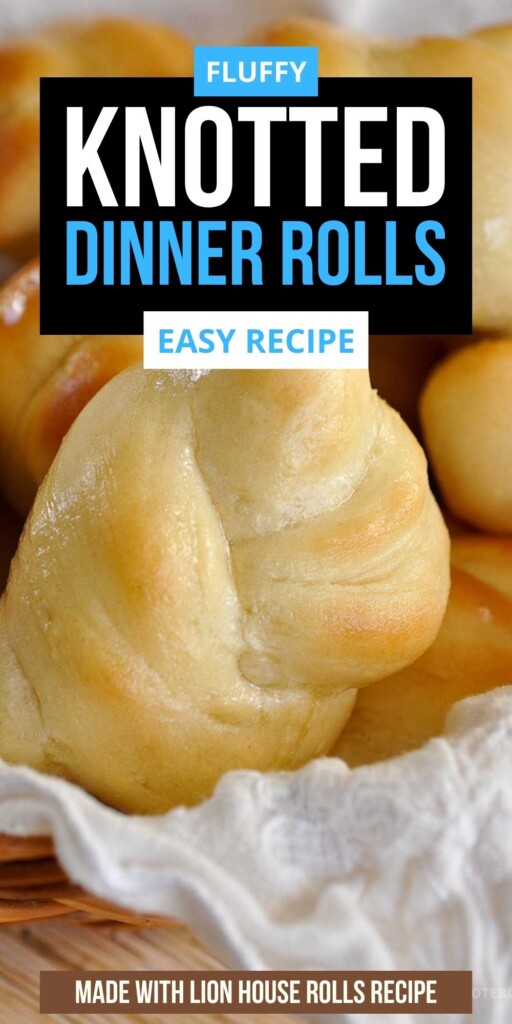
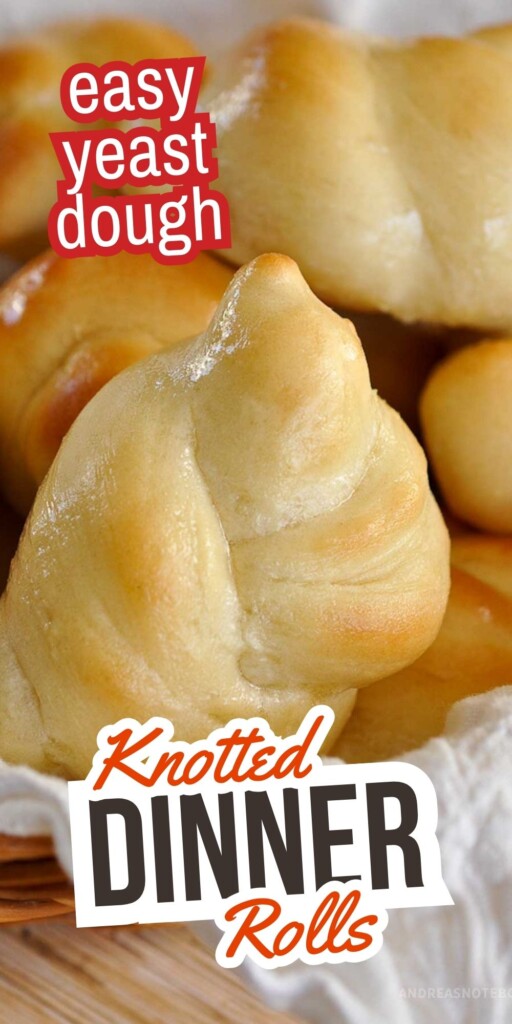

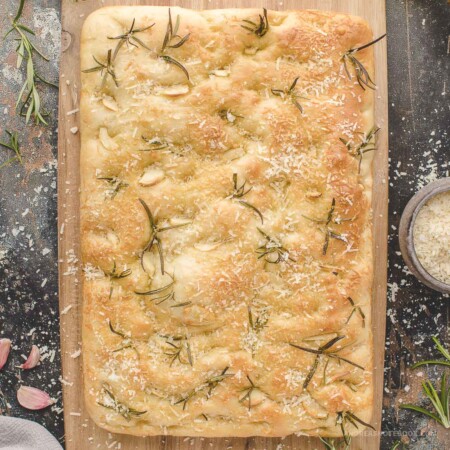
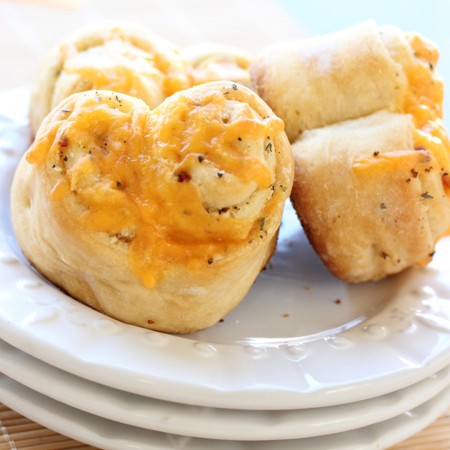
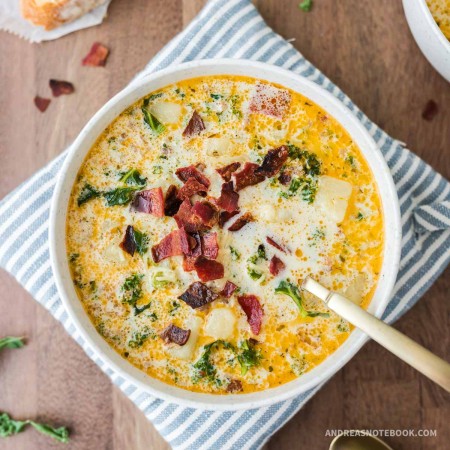
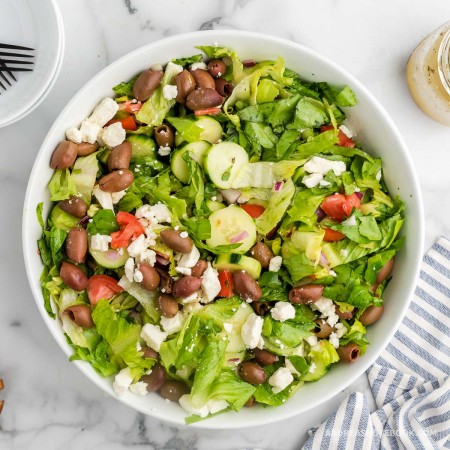

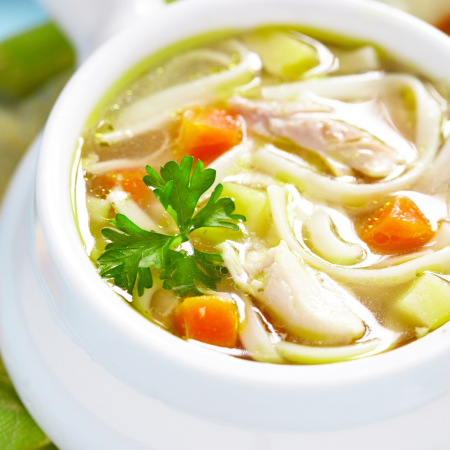
Comments & Reviews
Fran says
I need to multiply this recipe by six or seven, does it work well to double, triple, etc.?
Also, if you were to estimate what temperature your small room becomes for the rising what would that be? (I was thinking to place my rising bowls in double ovens and slightly heat the ovens to about 100 degrees, and then turn the ovens off before placing the dough there to rise.What do you think?
happy wheels says
Hello, Excellent writing! Thanks for delicious recipe. This dish looks yummy and healthy.
Jame says
good recipe! but I make it because butter is not good, so it tastes bitter.
cookie clicker
Morgan Bradshaw says
I love lion house rolls so this knotted version caught my attention. They turned out great! New favorite dinner rolls.
kadashika says
I will try it when I have time.